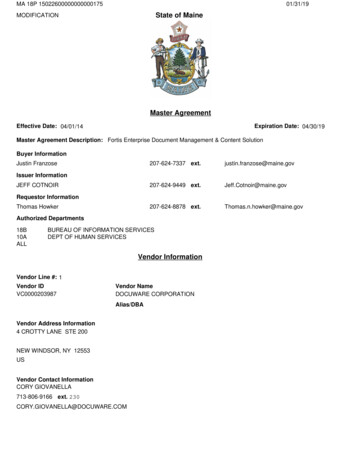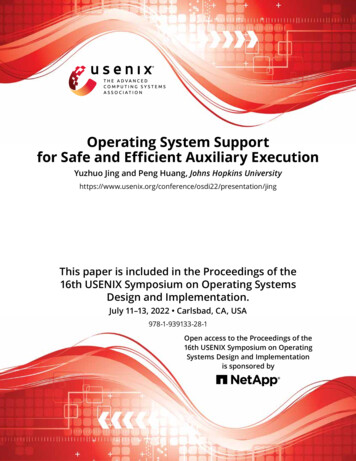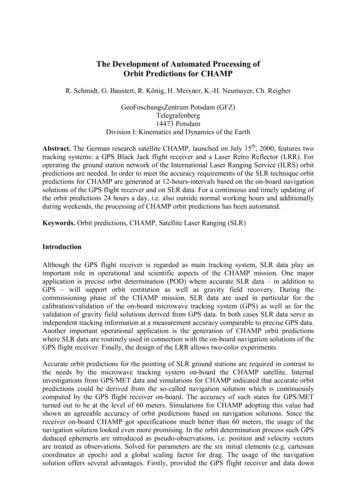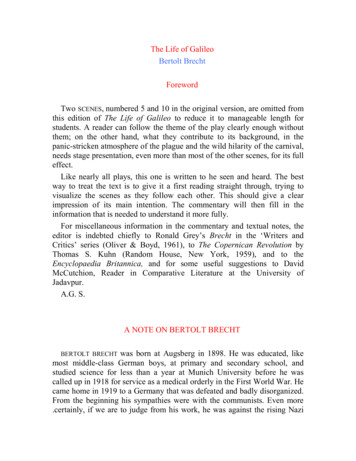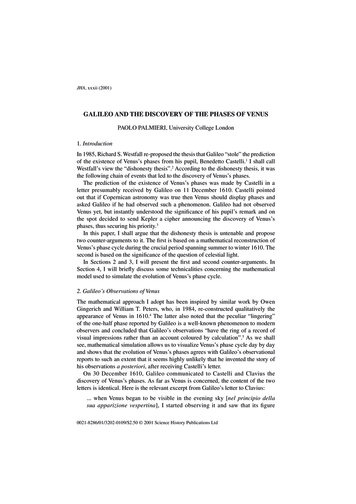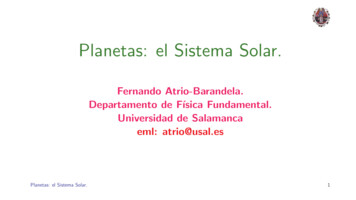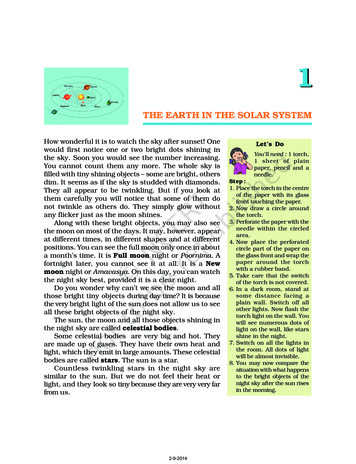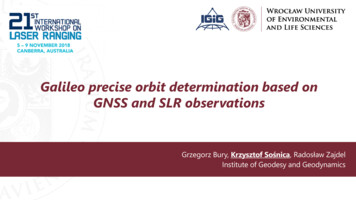
Transcription
Galileo precise orbit determination based onGNSS and SLR observationsGrzegorz Bury, Krzysztof Sośnica, Radosław ZajdelInstitute of Geodesy and Geodynamics
Direct Solar Radiation Pressure Solar wind Albedo Thermal effects Infrared Radiation Y-bias, B-bias Antenna Thrust
GNSS characteristics – the „Box-wing” s/galileo-satellite-metadataGPSX:Z ratio 5.7 : 5.4Galileo X:Z ratio 1.3 : 3.0Block IIF13.60Box surfacearea [X/Y/Z][m2]5.72/7.01/5.40IOV10.821.32/3.00/3.00FOC / FOC ecc.10.82SystemGPSGalileoTypeSolar panelsarea [m2]Altitude[km]Mass[kg]20 200155523 2006951.32/2.78/3.04 23 200 / 17 000-26 000708/645
SRP –„Box wing” model – accelerations in D and BGalileo orbit modelling is more challenging than for the GPS satellites
New Empirical CODE Orbit Model (ECOM2)Absorbs direct SRP onsolar panels and meanSRP acting on the bus& solar windArnold, D., Meindl, M., Beutler, G. et al.J Geod (2015) 89: b variations ofdirect SRP acting onthe bus𝑫𝟎 𝐷2𝐶 cos 2 𝑢 𝐷2𝑆 sin 2 𝑢𝐷𝑌0𝑌 𝐵0 𝐵1𝐶 cos 𝑢 𝐵1𝑆 sin 𝑢𝐵Limitations:Absorb thermaleffects to someextent(temperature lags)Absorb Y-bias and B-biasdue to the misalignment ofthe solar panels w.r.t. the Sun Albedo is not included Antenna thrust is not included (constant radial acceleration) Assumes yaw-steering (accounts only for the Y-bias and B-bias) Problems with eclipsing satellites (ECOM parameters 0 in Earth’s shadows & dynamic yaw-steering)
SRP –„Box wing” model –spectral analysis „Once-per-rev” are alwaysPeriodic errorwhen neglected:A 36 cmestimated in ECOM1/ECOM2 „Thrice-per-rev” are not usuallyestimated although they causesystematic errors during low βangles„Twice-per-rev”absorbedby ECOM2Periodic errorwhen neglected:A 15 cmPeriodic error forthe low β angles A 1.3 cm𝑫𝟎 𝐷2𝐶 cos 2 𝑢 𝐷2𝑆 sin 2 𝑢𝐷𝑌0𝑌 𝐵0 𝐵1𝐶 cos 𝑢 𝐵1𝑆 sin 𝑢𝐵
„Twice-per-rev”NOT absorbedby ECOM2A 2.6 cm„Thrice-per-rev”NOT absorbedby ECOM2SRP –„Box wing” model –spectral analysisThe current form of the ECOM2absorbsthe„Twice-per-rev”accelerationsA 2.7 cmintheD - direction – insufficient forthe elliptic Galileo„Once-per-rev”NOT absorbedby ECOM2Periodic errorwhen neglected:A 18 cm𝑫𝟎 𝐷2𝐶 cos 2 𝑢 𝐷2𝑆 sin 2 𝑢𝐷𝑌0𝑌 𝐵0 𝐵1𝐶 cos 𝑢 𝐵1𝑆 sin 𝑢𝐵
AlbedoInfrared radiation
NOT absorbedby ECOM2,A 6 cmAlbedo & IR – spectral analysis ECOM2 does not fully absorb thealbedo Not only the periodic perturbations,A 2.6 cmbut also the constant accelerationsresulting form IR has an impact onAbsorbed byECOM2,A 1.5 cmNOT absorbedby ECOM2,A 0.2 cmGNSS satellites𝑫𝟎 𝐷2𝐶 cos 2 𝑢 𝐷2𝑆 sin 2 𝑢𝐷𝑌0𝑌 𝐵0 𝐵1𝐶 cos 𝑢 𝐵1𝑆 sin 𝑢𝐵
Precise orbit determination usingthe box-wing model
The number of SLR observations to Galileo
SLR residuals microwave orbit validation using SLR data1-day arcs for 0-200 doy 2017SolutionBoxwingEmpirical OrbitParametersAlbedo 0,B0,B1S,B1CYESB2YESD0,Y0,B0,YESB1S,B1C,D2C, , D2SN2NOD0,Y0,B0,NOB1S,B1C,D2C, D2SYESFOC[mm] .753.7E23.127.3N2-29,130.8
SLR residuals to microwave orbit solution [mm]Box-wing (B1)β 14 RMS: 26 mmStandard ECOM2 solution (E2)β 14 RMS: 42 mm
The quality of Galileo orbit predictionsDays of predictionQuality of the 5-day orbit predictionsQuality of the orbit predictionsin the 12-hour interval
Precise orbit determination usingsolely SLR observations
Not only the Galileo satellites 3-day orbital arcs / No. of observations obtained in the 3-day interval (E2 model used)Microwave orbits form the CODE-MGEX solution
Galileo E20 orbitdetermination usingsolely SLR observationsBased on the orbit predictionsas an a priori,Determined using solely SLRComparison of E19 orbit determinedusing SLR with the CODE-MGEXproduct
Station coordinatesAltay (Russia) :RMS: 31.1 19.8 24.3 mm for North,East, Up, resp. in LAGEOS-1/2RMS: 17.1 16.5 16.6 mm for North,East, Up, resp. in LAGEOS GNSS fix132 solutions in LAGEOS-1/2161 solutions in LAGEOS GNSS(23% more solutions)GNSS-only solution
SummaryPrecise orbit determination of Galileo is more challenging than in case of GPS dueto lower masses and the higher X:Z bus surface ratio. POD of Galileo in eccentricorbits needs more coefficients to absorb all SRP effects (ECOM2 is insufficient).Using the a priori box-wing model gives similar POD results to ECOM2, but:(1) fewer coefficents have to be estimated (twice-per-rev are not needed),(2) orbit predictions become more stable than in case of ECOM2.The number of SLR observations to Galileo is being increasing due to the intensiveILRS tracking campaigns which allow for: (1) GNSS orbit validation, (2) POD ofGalileo, (3) determination of SLR-derived parameters, such as SLR stationcoordinates, geocenter motion and Earth rotation parameters.
Thank you for your attentionkrzysztof.sosnica@igig.up.wroc.pl
Back-up slides
Y-bias & B-bias
Do Galileo have any problems with the Y-bias?All Galileo FOC have problems with the Y-biasBased on CODE MGEX orbitsE19E14E08E12E18E30Galileo IOV – Y-bias close to 0Galileo ecc. – Y-bias -8x10-10m/s2 Galileo FOC – Y-bias -7x10-10m/s2
Do Galileo have any problems with the B-bias?Based on CODE MGEX orbitsE19E14E08E12E18E30Galileo IOV show some periodic variations of the B-bias (max when beta- max)
Radial, along-track, cross-track decompositionSpherical model:cos 𝛽 cos 𝑢𝑅𝑆 𝐷 cos 𝛽 sin 𝑢sin 𝛽𝑊
Galileo/GNSS orbit perturbation forces: Gravitational & General relativity C20 & time variability𝟒 𝟏𝟎 𝟓 𝐦/𝐬2 Earth’s gravity field𝟐 𝟏𝟎 𝟕 𝐦/𝐬2 Third celestial bodies𝟔 𝟏𝟎 𝟔 𝐦/𝐬2 Solid Earth, Ocean, Pole, Ocean Pole, Atmospheric tides𝟏 𝟏𝟎 𝟗 𝐦/𝐬2 Non-tidal ocean, hydrology, atmosphere mass variations𝟖 𝟏𝟎 𝟏𝟏 𝐦/𝐬2 Schwarzschild, Lense-Thirring, deSitter effects𝟓 𝟏𝟎 𝟏𝟎 𝐦/𝐬2Non-gravitational Direct Solar Radiation Pressure𝟏. 𝟏 𝟏𝟎 𝟕 𝐦/𝐬2 Albedo & Infrared Radiation𝟑 𝟏𝟎 𝟗 𝐦/𝐬2 Antenna Thrust𝟏 𝟏𝟎 𝟗 𝐦/𝐬2 Thermal effects 𝟔 𝟏𝟎 𝟏𝟎 𝐦/𝐬2 Y-bias Solar wind𝟕 𝟏𝟎 𝟏𝟎 𝐦/𝐬2 𝟓 𝟏𝟎 𝟏𝟎 𝐦/𝐬2
Direct SRP – „Box wing”EclipseVery small periodicvariationsmodel – accelerations in D
Direct SRP – „Box wing”Very small periodicperturbationsmodel – accelerations in BEclipseLarge variationseven for high beta
SLR validation of GNSS orbits (14 x 1-day solutions)SolutionBoxwingEmpirical OrbitParametersAlbedo YESB2YESD0,Y0,B0,B1S,B1C,D2C, ,Y0,B0,B1S,B1C,D2C, D2SYESN2NOD0,Y0,B0,B1S,B1C,D2C, D2SNOVery low quality for E0, E1, and N1 solutions - inacceptable for Galileo PODSimilar quality for B0, B1, B2, E2, which means that when using a priori box-wing model, the periodicempirical orbit parameters do not have to be estimated.B1 is sometimes even more stable than B2 (twice-per-rev parameters are not needed).
solar panels and mean SRP acting on the bus & solar wind Absorb Y-bias and B-bias due to the misalignment of the solar panels w.r.t. the Sun Absorb variations of direct SRP acting on the bus Absorb thermal effects to some extent (temperature lags) Limitations: Albedo is not included Antenna thrust is not included (constant radial .
